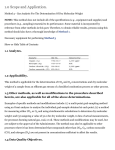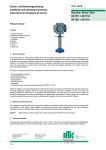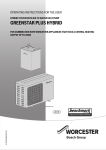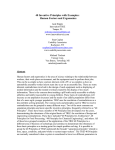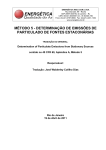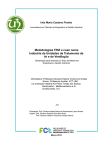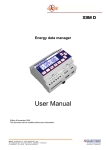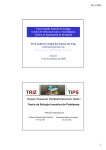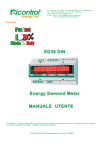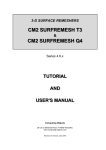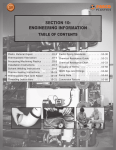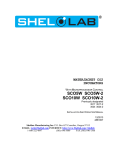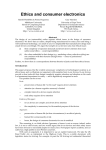Download 312 METHOD 3 - GAS ANALYSIS FOR THE
Transcript
312 METHOD 3 - GAS ANALYSIS FOR THE DETERMINATION OF DRY MOLECULAR WEIGHT NOTE: This method does not include all of the specifications (e.g., equipment and supplies) and procedures (e.g., sampling) essential to its performance. Some material is incorporated by reference from other methods in this part. Therefore, to obtain reliable results, persons using this method should also have a thorough knowledge of Method 1. 1.0 Scope and Application. 1.1 Analytes. Analyte CAS No. Sensitivity Oxygen (O2) 7782-44-7 2,000 ppmv Nitrogen (N2) 7727-37-9 N/A Carbon dioxide (CO2) 124-38-9 2,000 ppmv Carbon monoxide (CO) 630-08-0 N/A 1.2 Applicability. This method is applicable for the determination of CO2 and O2 concentrations and dry molecular weight of a sample from an effluent gas stream of a fossilfuel combustion process or other process. 1.3 Other methods, as well as modifications to the procedure described herein, are also applicable for all of the above determinations. modifications include: Examples of specific methods and (1) a multi-point grab sampling method using an Orsat analyzer to analyze the individual 313 grab sample obtained at each point; (2) a method for measuring either CO2 or O2 and using stoichiometric calculations to determine dry molecular weight; and (3) assigning a value of 30.0 for dry molecular weight, in lieu of actual measurements, for processes burning natural gas, coal, or oil. These methods and modifications may be used, but are subject to the approval of the Administrator. The method may also be applicable to other processes where it has been determined that compounds other than CO2, O2, carbon monoxide (CO), and nitrogen (N2) are not present in concentrations sufficient to affect the results. 1.4 Data Quality Objectives. Adherence to the requirements of this method will enhance the quality of the data obtained from air pollutant sampling methods. 2.0 Summary of Method. 2.1 A gas sample is extracted from a stack by one of the following methods: (1) single-point, grab sampling; (2) single-point, integrated sampling; or (3) multi-point, integrated sampling. CO2 and percent O2. The gas sample is analyzed for percent For dry molecular weight determination, either an Orsat or a Fyrite analyzer may be used for the analysis. 3.0 Definitions. 4.0 Interferences. [Reserved] 314 4.1 Several compounds can interfere, to varying degrees, with the results of Orsat or Fyrite analyses. Compounds that interfere with CO2 concentration measurement include acid gases (e.g., sulfur dioxide, hydrogen chloride); compounds that interfere with O2 concentration measurement include unsaturated hydrocarbons (e.g., acetone, acetylene), nitrous oxide, and ammonia. Ammonia reacts chemically with the O2 absorbing solution, and when present in the effluent gas stream must be removed before analysis. 5.0 Safety. 5.1 Disclaimer. This method may involve hazardous materials, operations, and equipment. This test method may not address all of the safety problems associated with its use. It is the responsibility of the user of this test method to establish appropriate safety and health practices and determine the applicability of regulatory limitations prior to performing this test method. 5.2 5.2.1 Corrosive Reagents. reagents: A typical Orsat analyzer requires four a gas-confining solution, CO2 absorbent, O2 absorbent, and CO absorbent. These reagents may contain potassium hydroxide, sodium hydroxide, cuprous chloride, cuprous sulfate, alkaline pyrogallic acid, and/or chromous 315 chloride. Follow manufacturer's operating instructions and observe all warning labels for reagent use. 5.2.2 A typical Fyrite analyzer contains zinc chloride, hydrochloric acid, and either potassium hydroxide or chromous chloride. Follow manufacturer's operating instructions and observe all warning labels for reagent use. 6.0 Equipment and Supplies. NOTE: As an alternative to the sampling apparatus and systems described herein, other sampling systems (e.g., liquid displacement) may be used, provided such systems are capable of obtaining a representative sample and maintaining a constant sampling rate, and are, otherwise, capable of yielding acceptable results. Use of such systems is subject to the approval of the Administrator. 6.1 6.1.1 Grab Sampling (See Figure 3-1). Probe. Stainless steel or borosilicate glass tubing equipped with an in-stack or out-of-stack filter to remove particulate matter (a plug of glass wool is satisfactory for this purpose). Any other materials, resistant to temperature at sampling conditions and inert to all components of the gas stream, may be used for the probe. Examples of such materials may include aluminum, copper, quartz glass, and Teflon. 316 6.1.2 Pump. A one-way squeeze bulb, or equivalent, to transport the gas sample to the analyzer. 6.2 Integrated Sampling (Figure 3-2). 6.2.1 Probe. Same as in Section 6.1.1. 6.2.2 Condenser. An air-cooled or water-cooled condenser, or other condenser no greater than 250 ml that will not remove O2, CO2, CO, and N2, to remove excess moisture which would interfere with the operation of the pump and flowmeter. 6.2.3 Valve. A needle valve, to adjust sample gas flow rate. 6.2.4 Pump. A leak-free, diaphragm-type pump, or equivalent, to transport sample gas to the flexible bag. Install a small surge tank between the pump and rate meter to eliminate the pulsation effect of the diaphragm pump on the rate meter. 6.2.5 Rate Meter. A rotameter, or equivalent, capable of measuring flow rate to ± 2 percent of the selected flow rate. A flow rate range of 500 to 1000 ml/min is suggested. 6.2.6 Flexible Bag. Any leak-free plastic (e.g., Tedlar, Mylar, Teflon) or plastic-coated aluminum (e.g., aluminized Mylar) bag, or equivalent, having a capacity consistent with the selected flow rate and duration of the 317 test run. A capacity in the range of 55 to 90 liters (1.9 to 3.2 ft3) is suggested. To leak-check the bag, connect it to a water manometer, and pressurize the bag to 5 to 10 cm H2O (2 to 4 in. H2O). Allow to stand for 10 minutes. Any displacement in the water manometer indicates a leak. An alternative leak-check method is to pressurize the bag to 5 to 10 cm (2 to 4 in.) H2O and allow to stand overnight. A deflated bag indicates a leak. 6.2.7 Pressure Gauge. A water-filled U-tube manometer, or equivalent, of about 30 cm (12 in.), for the flexible bag leak-check. 6.2.8 Vacuum Gauge. A mercury manometer, or equivalent, of at least 760 mm (30 in.) Hg, for the sampling train leak-check. 6.3 Analysis. An Orsat or Fyrite type combustion gas analyzer. 7.0 Reagents and Standards. 7.1 Reagents. As specified by the Orsat or Fyrite- type combustion analyzer manufacturer. 7.2 Standards. Two standard gas mixtures, traceable to National Institute of Standards and Technology (NIST) standards, to be used in auditing the accuracy of the analyzer and the analyzer operator technique: 318 7.2.1. Gas cylinder containing 2 to 4 percent O2 and 14 to 18 percent CO2. 7.2.2. Gas cylinder containing 2 to 4 percent CO2 and about 15 percent O2. 8.0 Sample Collection, Preservation, Storage, and Transport. 8.1 8.1.1 Single Point, Grab Sampling Procedure. The sampling point in the duct shall either be at the centroid of the cross section or at a point no closer to the walls than 1.0 m (3.3 ft), unless otherwise specified by the Administrator. 8.1.2 Set up the equipment as shown in Figure 3-1, making sure all connections ahead of the analyzer are tight. If an Orsat analyzer is used, it is recommended that the analyzer be leak-checked by following the procedure in Section 11.5; however, the leak-check is optional. 8.1.3 Place the probe in the stack, with the tip of the probe positioned at the sampling point. Purge the sampling line long enough to allow at least five exchanges. Draw a sample into the analyzer, and immediately analyze it for percent CO2 and percent O2 according to Section 11.2. 8.2 8.2.1 Single-Point, Integrated Sampling Procedure. The sampling point in the duct shall be located as specified in Section 8.1.1. 319 8.2.2 Leak-check (optional) the flexible bag as in Section 6.2.6. Figure 3-2. Set up the equipment as shown in Just before sampling, leak-check (optional) the train by placing a vacuum gauge at the condenser inlet, pulling a vacuum of at least 250 mm Hg (10 in. Hg), plugging the outlet at the quick disconnect, and then turning off the pump. The vacuum should remain stable for at least 0.5 minute. Evacuate the flexible bag. Connect the probe, and place it in the stack, with the tip of the probe positioned at the sampling point. Purge the sampling line. Next, connect the bag, and make sure that all connections are tight. 8.2.3 Sample Collection. (± 10 percent). Sample at a constant rate The sampling run should be simultaneous with, and for the same total length of time as, the pollutant emission rate determination. Collection of at least 28 liters (1.0 ft3) of sample gas is recommended; however, smaller volumes may be collected, if desired. 8.2.4 Obtain one integrated flue gas sample during each pollutant emission rate determination. Within 8 hours after the sample is taken, analyze it for percent CO2 and percent O2 using either an Orsat analyzer or a Fyrite type combustion gas analyzer according to Section 11.3. 320 NOTE: When using an Orsat analyzer, periodic Fyrite readings may be taken to verify/confirm the results obtained from the Orsat. 8.3 Multi-Point, Integrated Sampling Procedure. 8.3.1 Unless otherwise specified in an applicable regulation, or by the Administrator, a minimum of eight traverse points shall be used for circular stacks having diameters less than 0.61 m (24 in.), a minimum of nine shall be used for rectangular stacks having equivalent diameters less than 0.61 m (24 in.), and a minimum of 12 traverse points shall be used for all other cases. The traverse points shall be located according to Method 1. 8.3.2 Follow the procedures outlined in Sections 8.2.2 through 8.2.4, except for the following: Traverse all sampling points, and sample at each point for an equal length of time. Figure 3-3. Record sampling data as shown in 321 9.0 Quality Control. Section Quality Control Measure Effect 8.2 Use of Fyrite to confirm Orsat results. Ensures the accurate measurement of CO2 and O2. 10.1 Periodic audit of analyzer and operator technique. Ensures that the analyzer is operating properly and that the operator performs the sampling procedure correctly and accurately. 11.3 Replicable analyses of integrated samples. Minimizes experimental error. 10.0 Calibration and Standardization. 10.1 Analyzer. The analyzer and analyzer operator's technique should be audited periodically as follows: take a sample from a manifold containing a known mixture of CO2 and O2, and analyze according to the procedure in Section 11.3. Repeat this procedure until the measured concentration of three consecutive samples agrees with the stated value ± 0.5 percent. If necessary, take corrective action, as specified in the analyzer users manual. 10.2 Rotameter. The rotameter need not be calibrated, but should be cleaned and maintained according to the manufacturer's instruction. 11.0 Analytical Procedure. 322 11.1 Maintenance. The Orsat or Fyrite-type analyzer should be maintained and operated according to the manufacturers specifications. 11.2 Grab Sample Analysis. Use either an Orsat analyzer or a Fyrite-type combustion gas analyzer to measure O2 and CO2 concentration for dry molecular weight determination, using procedures as specified in the analyzer user's manual. If an Orsat analyzer is used, it is recommended that the Orsat leak-check, described in Section 11.5, be performed before this determination; however, the check is optional. Calculate the dry molecular weight as indicated in Section 12.0. Repeat the sampling, analysis, and calculation procedures until the dry molecular weights of any three grab samples differ from their mean by no more than 0.3 g/g-mole (0.3 lb/lb-mole). Average these three molecular weights, and report the results to the nearest 0.1 g/g-mole (0.1 lb/lb-mole). 11.3 Integrated Sample Analysis. Use either an Orsat analyzer or a Fyrite-type combustion gas analyzer to measure O2 and CO2 concentration for dry molecular weight determination, using procedures as specified in the analyzer user's manual. If an Orsat analyzer is used, it is recommended that the Orsat leak-check, described in Section 11.5, be performed before this determination; 323 however, the check is optional. Calculate the dry molecular weight as indicated in Section 12.0. Repeat the analysis and calculation procedures until the individual dry molecular weights for any three analyses differ from their mean by no more than 0.3 g/g-mole (0.3 lb/lb-mole). Average these three molecular weights, and report the results to the nearest 0.1 g/g-mole (0.1 lb/lb-mole). 11.4 Standardization. A periodic check of the reagents and of operator technique should be conducted at least once every three series of test runs as outlined in Section 10.1. 11.5 Leak-Check Procedure for Orsat Analyzer. an Orsat analyzer frequently causes it to leak. Moving Therefore, an Orsat analyzer should be thoroughly leak-checked on site before the flue gas sample is introduced into it. The procedure for leak-checking an Orsat analyzer is as follows: 11.5.1 Bring the liquid level in each pipette up to the reference mark on the capillary tubing, and then close the pipette stopcock. 11.5.2 Raise the leveling bulb sufficiently to bring the confining liquid meniscus onto the graduated portion of the burette, and then close the manifold stopcock. 11.5.3 Record the meniscus position. 324 11.5.4 Observe the meniscus in the burette and the liquid level in the pipette for movement over the next 4 minutes. 11.5.5 For the Orsat analyzer to pass the leak-check, two conditions must be met: 11.5.5.1 The liquid level in each pipette must not fall below the bottom of the capillary tubing during this 4-minute interval. 11.5.5.2 The meniscus in the burette must not change by more than 0.2 ml during this 4-minute interval. 11.5.6 If the analyzer fails the leak-check procedure, check all rubber connections and stopcocks to determine whether they might be the cause of the leak. Disassemble, clean, and regrease any leaking stopcocks. Replace leaking rubber connections. After the analyzer is reassembled, repeat the leak-check procedure. 12.0 Calculations and Data Analysis. 12.1 Md Nomenclature. = Dry molecular weight, g/g-mole (lb/lb-mole). %CO2 = Percent CO2 by volume, dry basis. %O2 = Percent O2 by volume, dry basis. %CO = Percent CO by volume, dry basis. %N2 = Percent N2 by volume, dry basis. 325 0.280 = Molecular weight of N2 or CO, divided by 100. 0.320 = Molecular weight of O2 divided by 100. 0.440 = Molecular weight of CO2 divided by 100. 12.2 Nitrogen, Carbon Monoxide Concentration. Determine the percentage of the gas that is N2 and CO by subtracting the sum of the percent CO2 and percent O2 from 100 percent. 12.3 Dry Molecular Weight. Use Equation 3-1 to calculate the dry molecular weight of the stack gas. M d ' 0.440(%CO2) % 0.320 (%O2) % 0.280 (%N2 % %CO) NOTE: Eq. 3-1 The above Equation 3-1 does not consider the effect on calculated dry molecular weight of argon in the effluent gas. The concentration of argon, with a molecular weight of 39.9, in ambient air is about 0.9 percent. A negative error of approximately 0.4 percent is introduced. The tester may choose to include argon in the analysis using procedures subject to approval of the Administrator. 13.0 Method Performance. [Reserved] 14.0 Pollution Prevention. 15.0 Waste Management. 16.0 References. [Reserved] [Reserved] 326 1. Altshuller, A.P. Plastic Bags. Pollution. 2. International Journal of Air and Water 6:75-81. 1963. Conner, William D. and J.S. Nader. with Plastic Bags. Air Sampling Journal of the American Industrial Hygiene Association. 3. Storage of Gases and Vapors in 25:291-297. 1964. Burrell Manual for Gas Analysts, Seventh edition. Burrell Corporation, 2223 Fifth Avenue, Pittsburgh, PA. 15219. 1951. 4. Mitchell, W.J. and M.R. Midgett. Reliability of the Orsat Analyzer. Control Association. 5. 26:491-495. Field Journal of Air Pollution May 1976. Shigehara, R.T., R.M. Neulicht, and W.S. Smith. Validating Orsat Analysis Data from Fossil Fuel-Fired Units. Stack Sampling News. 17.0 4(2):21-26. August 1976. Tables, Diagrams, Flowcharts, and Validation Data. 327 Filter (Glass Wool) Flexible Tubing Probe Squeeze Bulb Figure 3-1. Grab-Sampling Train. To Analyzer 328 Rate Meter Filter (Glass Wool) Valve Surge Tank Probe Quick Disconnect Air-Tight Pump Air-Cooled Condenser Bag Valve Figure 3-2. Rigid Container Integrated Gas-Sampling Train. 329 Time Traverse Point Q (liter/min) % Deviationa Average a %Dev. = [(Q - Qavg)/Qavg] x 100 Figure 3-3. Sampling Rate Data. (Must be < + 10 %)


















